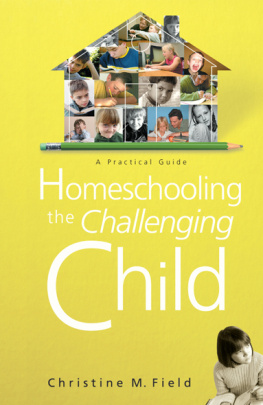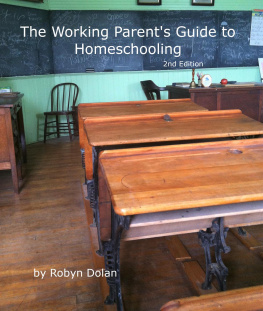8 Ways to StructureYour Homeschool Day:
Ideas for NewHomeschooling Families
By Jessica Locke
Copyright 2020 Jessica Locke
Table of Contents
8 Ways toStructure your Homeschool Day
Over the past years, homeschooling has grownincreasingly more common. With some parents choosing to homeschoolfrom the very beginning of their childs education, and otherschoosing to remove their children from the traditional schools theyhave attended previously, our local homeschooling communities havegrown into large communities of families aiming to educate theirchildren in a different, home based manner. This is where Ivefound myself and my family of six for the past eight years.
My husband and I both grew up in the publicschool system, and to be frank, I loved it. I thrived in school. Iwas a straight A student who took honors and AP courses wheneveravailable. Homeschooling was still a foreign concept to me, and asa parent, it was never an idea up for consideration as Itransitioned into parenthood. Eventually my oldest becameschool-age, and seeing as she was far ahead academically and missedthe school cut-off by just a few weeks, we committed to a singleyear of homeschooling to see if it would be a good fit for her.Once we made it through the first couple months, we fell in love.Eight years later, we are now homeschooling all four of ourchildren, and they are thriving in this environment.
Homeschooling has its challenges. One of thebiggest challenges that I found myself struggling through over theyears was how to schedule and structure our day. With only oneschool/education experience to draw upon personally, it took a lotof trial and error to find what fit our family life and learningstyles. At this point, we are incredibly flexible and utilizedifferent structures based on extenuating circumstances, co-opdays, appointments, etc.
There is no one size fits all in regards tothe schedule and structure of the homeschool world. That is quitepossibly the best first lesson I could pass on to a newhomeschooling family. What works for my family may not work foryours, and that is entirely okay. There are so many options andpossibilities for your homeschool day. It may take a little trialand error to figure out what works for you and your children. Iencourage you to allow yourself time needed to figure it all out.My goal with this ebook is to provide you with a handful of ideasfor how to structure and set up your homeschool day. With thisinfo, I hope that you are able to more easily implement structureand experiment with what works for you. I had always wished a moreexperienced homeschool mom would have given me some ideas with howto structure my day. In the beginning, I honestly didnt evenrealize that I had options. Now that I have tried many differentlayouts for our day, and found several that I love, I am passingthat information on to other homeschool moms and dads. Remember totry different approaches and figure out the structures which bestallow your child to thrive. The best thing about homeschooling isthat we can make it work very specifically for each of our children(and ourselves!).
As you read through these ideas andstrategies for structuring your homeschool day, keep in mind yourown particular circumstances. Families with a tired, pregnant mom,a newborn baby, crazy toddlers, or children with special needs needto keep in mind the individual right now needs of their family.There is beauty in the flexibility of homeschooling to fit intoyour every season of life. Allow yourself to adapt to the needs ofyour family as time goes on. What works well in one season may notwork when heading into a new season. It is okay to change up yourday, your structure, and your homeschooling approach.
Lastly, before we jump into some of the waysto structure your homeschool, I want to briefly bring awareness toyour own states rules and regulations regarding homeschooling.Each state has its own intricacies and those must be taken intoconsideration when planning your homeschool day. I live in Nevadaand our homeschooling laws are truly amazing. Some states are alittle stricter, requiring reporting or recording of yourhomeschool day or even a certain amount of hours spent per subject.When planning your day, be sure to take your states laws intoconsideration. All ideas listed in this book are ones that I myselfhave tried, currently utilize, or ones that some of my closehomeschooling friends utilize.
1.
Everyone Together Days
When all my children seem to wake up ineasy-going moods with positive learning attitudes and are all readyto go in the morning, we all end up at the table together. Theseare some of my favorite days, and I call them everyone togetherdays. Since everyone is gathered, these days are the easiest tostart with a Bible reading or devotional, which seems to set ourday up for success. You could alternately start with a story orbook the kids enjoy. We then typically move onto our sharedsubjects, which are history, geography, and science, as well asforeign languages or art, and read aloud books.
For our shared subjects, I often buy thecurricula for the oldest child, and then taper my expectationsbased on age, grade level, and interest in the subject matter athand. Well read together at the table or in the living room,answering questions or having side conversations as they come up.If the subject matter is too advanced for the younger children, Imight find a separate, more age appropriate book to read to themeither before or after the main book.
Everyone together days are great becausealthough I have multiple children at multiple levels of learning, Ican teach one science topic (or history or geography, etc.) at atime. This minimizes the amount of time spent teaching a particularsubject, and it provides a common topic for the children todiscuss.
Heres how this looks a little morepractically: My oldest and youngest are six years apart. When we doscience together, I do it at the table. I read with the book flatopen on the table for all to see, and Ill provide each child withcolored pencils and paper. As I read, they are encouraged to pick apicture off of the page and draw it. This enables even the youngestchild to find a connecting point to the topic at hand. Its amazinghow well all the children are able to listen while silentlycoloring at the same time. Children pipe in with questions as theycome up, and every child is able to participate in the same subjectall at once.
These days typically start with sharedsubjects and then move into individual subjects. Although everyonehas his own math lesson, not every child needs guidance at theget-go. Ill pass out assignments and then walk around to eachchild and offer guidance as needed. Well take breaks for playing,snack, chores, or reading. Reading aloud on the living room couchis by far one of the best parts of our day.
2.
Rotating Children Days
On days when children seem to be blissfullyplaying in their own little worlds, I will implement rotatingchildren days. While these days take a little longer to complete, Ienjoy the one on one time with my children that this type ofstructure provides.
I will look for a child who seems bored or isnot actively engaged in play with the rest of the children and pullthem over to do school with me. Well sit and work their subjectsone at a time. We can usually accomplish the bulk of theirschooling in under an hour when we do it one on one like this. Onceone child is done, Ill either send them off to finish someindependent work, or Ill dismiss them to go play and grab the nextchild.
While sometimes the non-schooling childrenare off and engaged in some sort of activity or play, other timesthey need something to do. In this case, I may ask them to tend tothe garden, take care of the dogs and chickens, bake or cooksomething that is needed for that day, or do a load of laundry.These tasks are real-life skills that allow them to stay focusedand busy and out of trouble while I work with and focus on anotherchild. While these days take a little longer since Im only doingschool with one child at a time, we often accomplish a lotaltogether since the kids are all working on much-needed householdtasks.










